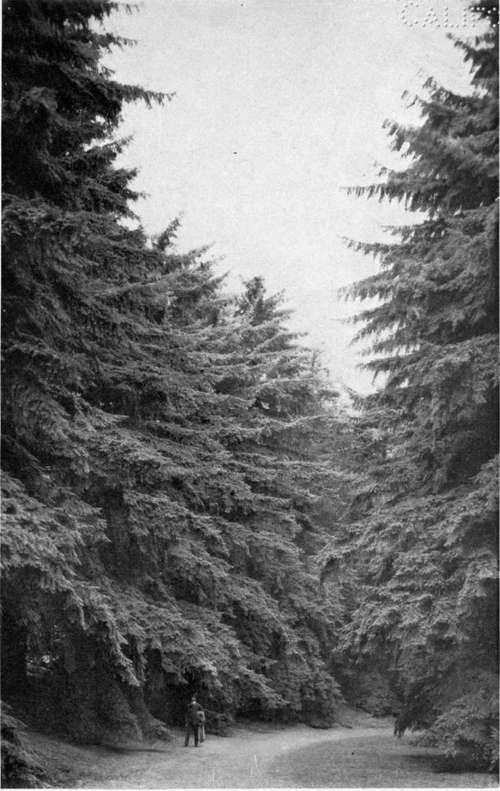Our Equivalent For The Cedar Of Lebanon
Description
This section is from the book "What England Can Teach Us About Gardening", by Wilhelm Miller. Also available from Amazon: What England Can Teach Us About Gardening.
Our Equivalent For The Cedar Of Lebanon
As the yew is the most decorative conifer in England, so the cedar of Lebanon is the most picturesque (see plates, 61, 63). You see it everywhere, centuries old, the pride of every country gentleman's estate. In Asia Minor specimens have lived two thousand years. The peculiar glory of this cedar is the perfection of its strata. It is a very open tree, and its successive tiers or platforms of foliage 'are spread out for every one to enjoy. It also has very interesting cones. We have absolutely nothing like it growing wild in America.

See how small the man is in comparison with these douglas spruces which have grown ioo feet in sixty years in england! the california form of the douglas spruce is not hardy in the east. but the colorado is. never buy a douglas spruce without asking which form your nurseryman has. murthly castle, perth, w. s. fotheringham, esq. See page 151.
Of all the foreign conifers the cedar of Lebanon is the most conspicuous in England, but it is also the most thoroughly at home. Technically, this is not true, because it does not "self-sow," but humanly speaking it fits the landscape to perfection. It never has the stern or tragic look of our picturesque conifers, eloquent of a thousand battles lost and won. The mellowness of old England has descended upon it like a benediction.
But never has a grander personality made a poorer start in life. A young cedar of Lebanon grows very slowly and has little beauty. At the time when other conifers are symmetrical and graceful it is a rough, tousled mass of harsh foliage having the texture of the larch. But in old age and at a distance the foliage-effect becomes wonderfully soft and the whole tree assumes a prophetic appearance, so that one is transported as if by magic to Old Testament times.
Unfortunately the cedar of Lebanon is generally a failure in America, especially north of New York. But Professor Sargent is doing a splendid work in sending explorers for the hardiest forms of the most important trees, and the Arnold Arboretum has a stock of Cedrus Libani raised from seeds found in the northernmost mountains of the Taurus range and at the highest altitude where this cedar grows.
But even if Professor Sargent's form of the cedar of Lebanon should prove disappointing there is another cedar which is certainly hardier than the common stock and in old age it cannot be distinguished from the cedar of Lebanon. This is the Mount Atlas cedar (Cedrus Atlanticd), which Mr. William Robinson believes is only a geographical variation of the cedar of Lebanon and not a distinct species. In the young state, the African cedar has an upright leader, while that of the Lebanon cedar is nodding. The leaves of the former are generally less than an inch long and thicker than broad, while those of the latter are an inch or more long and broader than thick. But their landscape effects are identical (see plate 61).
At the home of Major Rogers, Sevenoaks, Kent, I saw a cedar of Lebanon practically one hundred feet high which was planted in 1815. At Enfield I paced under one about two hundred and fifty years old which had a spread of over one hundred feet.
"No finer things than the cedars can be within the view of the flower garden," says William Robinson, "but they should never be planted near the house, or their great branches will darken it and in small flower gardens they are sure to be in the way".
Continue to:
Tags
garden, flowers, plants, England, effects, foliage, gardening
